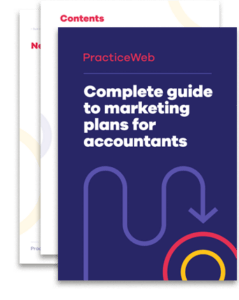It’s so tempting to wing it, follow your gut or rely on ‘common sense’ but the best results always come from a methodical approach.
When it comes to building your accountancy firm’s marketing funnel so you can generate the maximum number of quality leads, that means taking the time to fine tune your customer relationship management system (CRM) and website analytics tools.
That’s doubly true at a time when leads might be harder to acquire for various reasons.
There’s the uncertainty, for one thing – when will we come out of lockdown? When we do, will people want to shop, travel, visit pubs and restaurants?
And as everyone tightens their belts to build a cash cushion, every bit of spending is being scrutinised with extra care. For many businesses, now certainly doesn’t feel like the time to purchase additional services or change suppliers.
No to mention the fact that around half of UK businesses have people working from home, some on reduced hours, while millions of people have been furloughed. Even when someone is ready to buy, it can be a challenge to get final decisions signed off and paperwork agreed.
Building your marketing funnel – getting more leads, of the right type – is certainly one way to address this. But before you get to that, we’d advise investing some time on getting the basics right.
Customer data and CRM systems
A decent CRM system, with up-to-date and detailed data on clients and prospects, does four things:
- Makes it easy to track the progress of leads through the marketing funnel.
- Prevents promising leads getting lost or dropped through inaction or miscommunication between sales people.
- Helps maximise the value of existing client relationships – who among your current client base might be open to buying more services from your firm?
- Makes launching laser-targeted marketing campaigns fast and easy.
As with any database – that’s basically what a CRM is – the trick is, first, to plan carefully what information you want to capture.
Think hard about what you need to know to make smart decisions, while also resisting the urge to record too much information.
If every time someone on your team identifies a lead they have to fill in a hundred fields, the chances are they’ll get sloppy, or put the job off until later or, worse, stop bothering at all.
As a bare minimum, though, you probably need to know which services they’re already signed up for, which they’ve expressed interest in buying in the future and how responsive they are to those conversations.
Secondly, maintain the data religiously. Make sure you and your team are in the habit of reviewing each client’s record immediately after every call or contact, even if you don’t think there’s anything to update.
For example, there’s nothing more embarrassing – or more damaging to the relationship – than multiple contacts from different people in the same week at a time when the client has already made clear they’re under pressure or categorically uninterested.
It’s also good practice to run data cleansing operations on a regular basis – perhaps once a quarter or every six months. One common problem is duplicate records, where client businesses have changed names, launched spin-offs or even split in two as the result of partnership disputes.
Data capture via your website
The more data you can get clients to provide themselves, the better.
If you’ve got valuable content on your website – downloadable eBooks, for example, or white papers – consider putting those behind gates that require a user to enter contact details for access.
Make sure your contact forms ask for key information upfront so that your team already knows as much as possible before speaking directly to each prospect.
Again, it’s a fine balance: ask for too much information and people are less likely to bother. Remember, though, that this is in itself a form of pre-qualification, weeding out what in the motor-trade might be called ‘tyre kickers’.
If you can, make sure the data from web forms goes directly into your CRM system. It’s a one-time job to set this up and will save you hours of effort of manual input in the future.
The platform upon which PracticeWeb builds websites for accountants, Horizon, integrates seamlessly with most major CRMs including Salesforce, as well as specialised accountancy practice management software such as Senta.
Website user data and Google Analytics
Google Analytics is a free tool for monitoring and measuring website traffic.
We recommend it to all of our accounting clients and setup comes as standard with our accountancy websites.
It’s a fantastic way to better understand your audience and provides hard data that will give you a solid foundation for an intelligent marketing strategy. You’d be surprised at how often what it tells you isn’t what you expected to see – again, assumptions are dangerous in this game.
To really get the most out of your Analytics account, though, you need to:
- Customise and optimise your dashboard.
- Set some smart goals against which to track performance.
Google Analytics is a massively powerful tool but it can also be a bit overwhelming. There is a wealth of useful tools and readouts broken down into different sections, presented as lists, links, maps, graphs… Where do you start?
Fortunately, Google provides plenty of brilliant training materials, and we’d really recommend investing some time in completing this course in particular.
‘Google Analytics for Beginners’ will take between four and six hours to complete and covers:
- navigating the Google Analytics interface
- understanding reports
- setting up your dashboard
- analysing audience, acquisition, and behavior reports
- setting up goals and campaign tracking.
Knowing what’s working and what’s not is vital to making sure your website is achieving the results you want, and that you’re making the very most of your marketing budget.
Putting you in control
It’s a great feeling when you’ve got all these underlying systems up to date, smartly integrated and providing the reports you need within a couple of clicks.
A bit like tidying your desk or weeding the garden, it brings a sense of calm and control. You can find the information you need more quickly and make smarter, faster decisions.
Once you’ve done this (don’t put it off, do it today) you’ll be in a good place to start building a really smart, truly effective marketing strategy, aligning your business goals with marketing goals and managing your budget, and delivering an impressive return on investment.
Talk to us for advice on generating leads for your accountancy firm and download our next guide to marketing plans for accountants.
Like and share using the buttons below.





